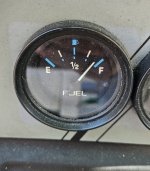When I get a new to me boat and every once in a while I do a test on my tank and gage. I use two gallon portable fuel cans as they are easy to handle. I use my pump to get as much fuel out as possible ( usually at end of season for winter storage). Because it is a plastic tank, there is very little chance of moisture from condensation like there is in a metal tank. In the spring, I add two gallons at a time and watch the fuel gage and make note where it reads. I have a little gage I made to show how my boat sits in the water as far as how level it sits. I adjust my trailer so my boat sits at that same angle. I keep adding two gallons and noting the gage reading, until the tank is full. I now know where every two gallons is marked on my gage and also have a total usable number of gallons availiable. I can run my boat down to the last two gallons if needed. I usually fill it up when it reads about 3/4 empty. At this level, I know I have enough fuel to get back from wherever I normally go. During the busy fishing season, I just fillup after every three fishing trips, about half a tank so I don't forget. But, if you do this little test each spring, you will know if anything changes and needs addressed.





















